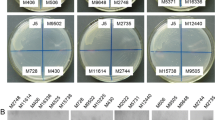Abstract.
The D- and L-specific nicotine oxidases are flavoproteins involved in the oxidative degradation of nicotine by the Gram-positive soil bacterium Arthrobacter nicotinovorans. Their structural genes are located on a 160-kbp plasmid together with those of other nicotine-degrading enzymes. They are structurally unrelated at the DNA as well as at the protein level. Each of these oxidases possesses a high degree of substrate specificity; their catalytic stereoselectivity is absolute, although they are able to bind both enantiomeric substrates with a similar affinity. It appears that the existence of these enzymes is the result of convergent evolution. The amino acid sequence of 6-hydroxy-l-nicotine oxidase (EC 1.5.3.6) as derived from the respective structural gene shows considerable structural similarity with eukaryotic monoamine oxidases (EC 1.4.3.4) but not with monoamine oxidases from prokaryotic bacteria including those of the genus Arthrobacter. These similarities are not confined to the nucleotide-binding sites. A 100-amino acid stretch at the N-terminal regions of 6-hydroxy-l-nicotine oxidase and human monoamine oxidases A possess a 35% homology. Overall, 27.0, 26.9, and 25.8% of the amino acid positions of the monoamine oxidases of Aspergillus niger (N), humans (A), and rainbow trout (Salmo gairdneri) are identical to those of 6-hydroxy-l-nicotine oxidase (Smith–Waterman algorithm). In addition, the G+C content of the latter enzyme is in the range of that of eukaryotic monoamine oxidases and definitely lower than that of the A. nicotinovorans DNA and even that of the pAO1 DNA. The primary structure of 6-hydroxy-d-nicotine oxidase (EC 1.5.3.5) does not reveal its evolutionary history as easily. Significant similarities are found with a mitomycin radical oxidase from Streptomyces lavendulae (23.3%) and a ``hypothetical protein'' from Mycobacterium tuberculosis (26.0%). It is proposed that the plasmid-encoded gene of 6-hydroxy-l-nicotine oxidase evolved after horizontal transfer from an eukaryotic source.
Similar content being viewed by others
Author information
Authors and Affiliations
Additional information
Received: 6 March 1998 / Accepted: 15 July 1998
Rights and permissions
About this article
Cite this article
Schenk, S., Decker, K. Horizontal Gene Transfer Involved in the Convergent Evolution of the Plasmid-Encoded Enantioselective 6-Hydroxynicotine Oxidases. J Mol Evol 48, 178–186 (1999). https://doi.org/10.1007/PL00006456
Published:
Issue Date:
DOI: https://doi.org/10.1007/PL00006456




